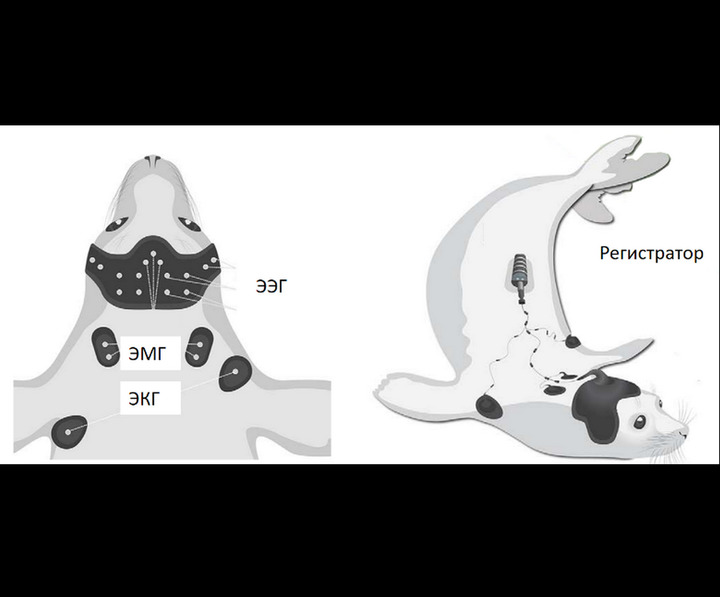Russian biologist Lyamin told how scientists unraveled the dreams of sea elephants
[ad_1]
Why do scientists study animal sleep? To answer many questions about human sleep. Oleg Lyamin is a leading wild animal sleep specialist in Russia and known throughout the world. We met five years ago when he returned from the Republic of South Africa, where he caught “earthly” elephants in the Chobe National Park and attached motion sensors (accelerometers) to them to find out sleep features of these giants. For many years, the biologist also studied the sleep of marine mammals at the Utrish marine scientific station of the IPEE named after. A.N. Severtsov RAS, near Novorossiysk. Under the guidance of another prominent scientist, Lev Mukhametov, they studied the sleep of dolphins, beluga whales, killer whales. It is to this group that the discovery of unihemispheric sleep in cetaceans and fur seals belongs, as well as studies of the sleep of walruses, manatees, and many other mammals. However, the dreams of seals and, in particular, elephant seals living off the coast of California, have long remained a mystery to scientists.
According to Lyamin, back in the late 1970s, when Americans studied the behavior of northern elephant seals (Mirounga angustirostris) during migrations in the Pacific Ocean, which they have 7 months a year, it was clear that these animals are “professional » divers. They may not appear on the surface for more than an hour and dive to depths of more than 1 km. To stock up on air, they emerge for a few minutes. Most of the day they are occupied by the process of searching for and eating fish, which require a lot to satisfy the needs of a huge organism weighing up to several tons. But when do they sleep?
Help “MK”.
Bottlenose dolphins and killer whales usually dive to 150-200 meters and can only go without air for 5-7 minutes.
Help “MK”.
Seals accumulate oxygen “for the future” during short ascents to the surface by hyperventilating the lungs, that is, they take many breaths in a short time.
In 2016, a team of zoologists and neuroscientists gathered by Jessica M. Kendall-Bar from the Scripps Institution of Oceanography (USA) became interested in the problem of elephant seal sleep.
How did your research start?
– Jessica, as a student, came to us on Utrish, was interested in our research, helped, prepared. Then, when she started the project, she invited me to take part in research on the sleep of elephant seals in the ocean. Frankly, all this seemed to me out of the realm of fantasy … As a result, we managed to non-invasively (from the surface of the skin) register the electroencephalogram of the cerebral cortex (EEG) of seals, their heart rate (ECG), muscle tone (myogram), as well as parameters motor activity and diving depth.

– Tell us more about how you did it?
– At the first stage, 13 young seals, over a year old and about one and a half meters long, participated in the experiment. They were selected from a large elephant rookery in Monterey Bay. The big problem for us was to install sensors on them and fix them so that they would not be shorted out and washed away with water. And, of course, make it all work.
– Were they some kind of special electrodes for recording readings through a thick layer of subcutaneous fat?
– They were ordinary, skin, which are used to record the electrical activity of the human brain, but the recording method itself had to be improved, setting them up for work. Jessica, before attaching them to the body of the first elephant seal, tested them … on herself – she tried to sleep with them in the water (smiles). It should be noted that the aquatic environment is not alien to her – she is seriously interested in scuba diving.
The main problem was the protection of sensors from water and mechanical stress. The electrodes were glued to the scalp of a temporarily euthanized seal, and a rubber base was glued on top – at least 2 layers of material from which wetsuits are made. It turned out to be a hat.
– What kind of glue did you use?
– Approximately the one with which the details of the suits of scuba divers are glued together. This glue can stay in water for several months. The rubber layer with electrodes can be quickly removed. Everything else fell off during the molting of the animal.
– How many sensors and devices were there in total on the body of each elephant seal before being released into the ocean?
– There were 20 electrodes alone. Add motion sensors (accelerometers) and GPS trackers to them. Each elephant was like a huge floating computer (smiles).
– Why was it necessary to determine muscle tone and record the work of the heart?
– To record sleep itself, as well as the phase of REM or REM sleep, during which muscle tone drops to zero, the heart rate becomes rare and irregular, and the brain is active, as in wakefulness! It is REM sleep that accounts for most of our dreams. At the same time, it is deeper, makes animals vulnerable. But, nevertheless, we need it for something, if almost all mammals have it, with the exception of dolphins.
By the way, the recorder of brain activity, muscle tone and heart function was made for us by our compatriot Alexei Vysotsky, who has been living and working in Zurich for a long time. For the device, we made a hermetic case, which was attached to the back of the animal with glue in the same way as the electrodes. All electrodes were connected to the device by wires.
– So, what did you find out?

– We learned that elephant seals sleep by diving underwater to a depth of 377 meters. This is not surprising, since near the surface at depths of 100 to 200 meters they can become easy prey for sharks and killer whales. During the dive, they successively fall asleep, first with slow-wave, and then paradoxical, REM sleep. The two stages of sleep were characterized by different postures: during NREM sleep, the elephant seals sank smoothly into a “normal” position (back up)—to the uninitiated, it might seem that the elephant was drowning. With the onset of REM sleep, which is characterized by atony (complete lack of skeletal muscle tone) and muscle tremors, they rolled over on their backs, circling in a spiral and resembling a falling leaf. The diameter of this “REM sleep helix” gradually decreased. One dive for sleep accounted for an average of 20 minutes.
– And the seal was without air all this time?
– Yes, in fact, most of the time his body experienced severe hypoxia (at least in our view). Then the animals woke up and floated to the surface of the water for breathing for several minutes, and then dived again. Dives for sleep alternated with dives for feeding fish, squid, and the last dives were many times more. And so 7 months a year.
As a result, by comparing the parameters of movement, posture, movement profile and depth of immersion in several hundred elephants, we calculated that the average duration of sleep in these animals in the ocean during a migration period of 7 months is an average of only 2 hours per day. By the way, using GPS coordinates, we found their favorite places to sleep and compiled a special map that will be useful to those involved in environmental activities.
Returning to the rookery (seals always return to where they went on a journey), they “returned” to us all the expensive sensors. By the way, the cost of equipment on one animal is comparable to the cost of a new budget car.
Freed from scientific equipment, our hard workers fell into sleep and indulged in it for 11 hours a day, that is, 5 times more than it happened in the ocean.
“They seem to have slept off for long months of wandering …
– Looks like it.
– Could this study somehow answer questions about human sleep?
– The data obtained, which we recently published in magazine Science is another example of the flexibility and diversity of animal sleep, as well as its dependence on external factors and living conditions. We now understand quite well how mammals sleep in water. Cetaceans and fur seals are half the brain in motion and maintain constant control of what is happening around them during their sleep. Elephant seals and other seals – sleep with all their brains, like us, but hold their breath, turn off, and hide in the depths, and wake up at the right time. The new data is important for fundamental science, for understanding the functions of sleep, which, in fact, are not completely clear to us.
– How incomprehensible? Sleep is essential for gaining strength.
– Yes, the classical point of view considers sleep as a restorative process for the whole organism, another, no less popular, says that sleep is needed for cognitive processes (if you sleep more, your brain will work better). Tell the elephant seals, fur seals and dolphins about it! In conditions of maximum stress associated with the need to constantly dive, look for food, then, having surfaced, catch your breath 2-3 minutes before the next dive … At the same time, we must not forget about the predators that lie in wait near the surface of the water! Do you think you get tired at the end of the work week? Remember these moments about sea animals! (smiles).
– If we figure out how they manage to be so efficient, we can sleep less and not get tired?
“We are coming to understand that every animal, including humans, has adapted to sleep exactly in the conditions in which it lives. Sleep is inseparable from the environment. It also helps the animal to survive. It has taken millions of years for elephant seals, fur seals and dolphins to learn to sleep the way they do. Today, millions of people complain about sleep problems – suffer from insomnia, daytime sleepiness. Oxygen starvation (hypoxia) disrupts brain function, often irreversibly, as in the case of strokes … Of course, the ability of sea elephants to live in conditions of sleep deprivation and the resistance of their brain to lack of oxygen deserves the most serious attention and research.
[ad_2]
Source link








